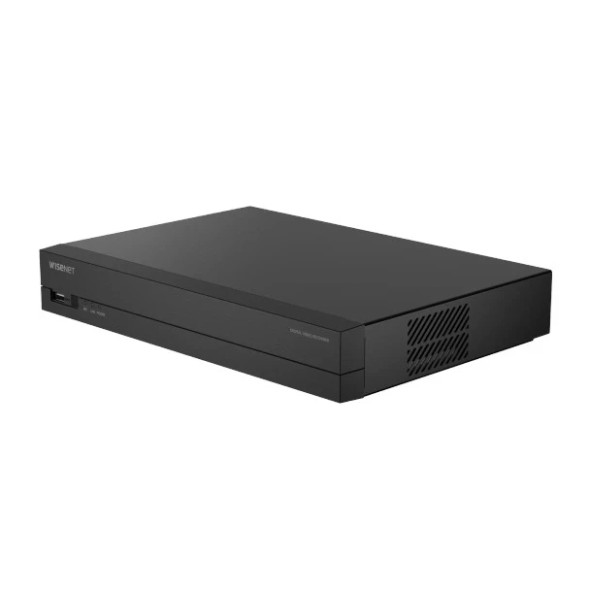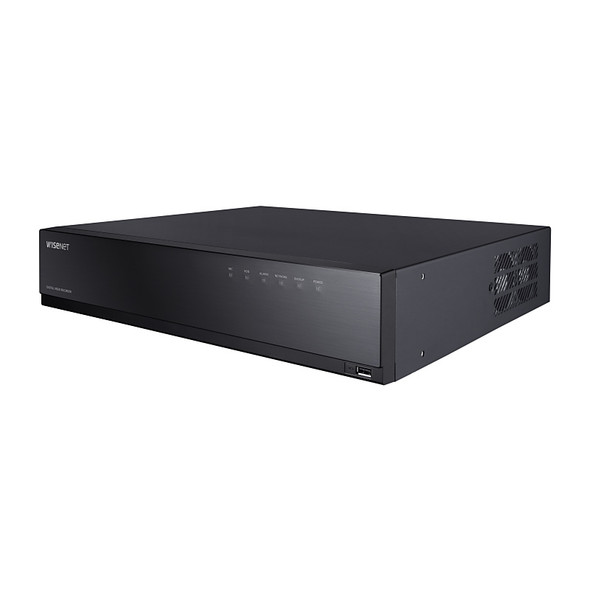Hybrid Video Recorders
The DIVAR hybrid recorders can simultaneously record and view video from traditional analog cameras as well as the latest IP security cameras. The recorder can be connected to the following camera configurations:
- A maximum 16 analog cameras recording at resolutions up to 960H
- A combination of maximum 16 analog cameras and maximum 16 IP cameras
Key features of Hybrid Video Recorders
- Integration of Analog and IP Cameras: Hybrid video recorders are designed to work with both analog and IP (Internet Protocol) cameras. This flexibility allows users to upgrade their surveillance systems gradually, transitioning from analog to digital cameras.
- Analog Compatibility: These recorders often support traditional analog cameras using technologies such as analog high definition (AHD), high definition composite video interface (HD-CVI), or high definition transport video interface (HD-TVI).
- IP Camera Support: Hybrid recorders also support IP cameras, which provide higher resolution and additional features. IP cameras use network cables for both data and power (Power over Ethernet or PoE).
- Versatility: Users can choose the type of cameras that best suit their requirements and budget, allowing for a mix of analog and IP cameras in the same surveillance system.
- User Interface and Configuration: The user interface of hybrid video recorders is designed to be user-friendly, allowing for easy configuration, management, and retrieval of recorded footage.
- Remote Access and Management: Many hybrid video recorders come with features for remote access and management. This allows users to view the live or recorded footage from their surveillance cameras using web browsers or dedicated mobile apps.
- Storage Options: Hybrid recorders typically have built-in storage or support external storage devices such as hard drives. The amount of storage needed depends on factors like the number of cameras, resolution, and recording settings.
- Scalability: Hybrid systems offer scalability, enabling users to expand their surveillance infrastructure by adding more cameras or upgrading existing ones without replacing the entire system.
- Video Compression: These recorders often use advanced video compression techniques (such as H.264, H.265) to efficiently store video footage while maintaining good image quality.
- Motion Detection and Alerts: Hybrid recorders may include motion detection capabilities, sending alerts or notifications when motion is detected in specific areas covered by the cameras.
What is a hybrid recorder?
A hybrid recorder is a versatile video recording device commonly employed in surveillance systems. Its defining feature lies in its ability to seamlessly integrate and manage both analog and digital IP cameras. This adaptability allows users to combine traditional analog cameras with more advanced IP cameras in a single surveillance infrastructure. Hybrid recorders offer scalability, enabling users to upgrade and expand their systems incrementally. These devices typically support various video compression technologies for efficient storage and retrieval of footage. With remote access capabilities, users can monitor live feeds and review recorded content from their cameras using web browsers or dedicated mobile applications. The hybrid recorder serves as a flexible solution for security applications, accommodating diverse camera technologies and providing a user-friendly interface for configuration and management.
What is a hybrid NVR?
What is hybrid camera system?
A hybrid camera system refers to a surveillance setup that combines different types of cameras, typically analog and IP cameras, within the same surveillance network. This configuration allows users to leverage the benefits of both analog and digital technologies in a single system.
Analog cameras are traditional cameras that transmit video signals over coaxial cables, while IP cameras use network cables and transmit digital data. A hybrid camera system provides versatility by accommodating both camera types. This is particularly useful for users who have an existing analog camera infrastructure but want to upgrade to higher-resolution IP cameras gradually.
Key features of a hybrid camera system may include:
- Mixed Camera Support: The ability to integrate and manage both analog and IP cameras within the same system.
- Scalability: Users can expand or upgrade their surveillance system by adding more IP cameras without completely overhauling the existing analog infrastructure.
- Remote Access: Many hybrid systems offer remote access capabilities, allowing users to view live or recorded footage over the internet.
- Storage Options: Hybrid systems typically support various storage options, including internal hard drives or external storage devices, to store video recordings.
- User-Friendly Interface: An intuitive interface for easy configuration, management, and monitoring of the entire camera system.
By combining the strengths of analog and IP technologies, hybrid camera systems offer a cost-effective and flexible solution for surveillance needs, accommodating various camera types and allowing for a phased transition to more advanced digital systems.
-
New Product!

Hanwha Vision ARD-810-2TB 8 Channel 5MP Hybrid Video Recorder with 2TB HDD Included
Brand: Hanwha Vision
Part Number: ARD-810-2TB$592.00$481.25- Compression : H.264, H.265, MJPEG,
- Pre-Installed Storage : 2 TB
- Hard Drive Ports : 1 SATA Port
- Max. Storage Capacity : 6 TB Storage Capacity
- Color : Black
- Material : Metal
$592.00$481.25 -
New Product!

Hanwha Vision ARD-810 8 Channel 5MP Hybrid Video Recorder with No HDD Included
Brand: Hanwha Vision
Part Number: ARD-810$352.00$294.35- Compression : H.265, H.264, MJPEG,
- Pre-Installed Storage : No HDD included
- Hard Drive Ports : 1 SATA Port
- Max. Storage Capacity : 6 TB Storage Capacity
- Color : Black
- Material : Metal
$352.00$294.35 -
New Product!

Hanwha Vision ARD-410-2TB 4 Channel 5MP Hybrid Video Recorder with 2TB HDD Included
Brand: Hanwha Vision
Part Number: ARD-410-2TB$460.00$384.55- Compression : H.264, H.265, MJPEG,
- Pre-Installed Storage : 2 TB
- Hard Drive Ports : 1 SATA Port
- Max. Storage Capacity : 6 TB Storage Capacity
- Color : Black
- Material : Metal
$460.00$384.55 -
New Product!

Hanwha Vision ARD-1610-4TB 16 Channel 5MP Hybrid Video Recorder with 4TB HDD Included
Brand: Hanwha Vision
Part Number: ARD-1610-4TB$1,063.00$865.95- Compression : H.265, H.264, MJPEG,
- Pre-Installed Storage : 4 TB
- Hard Drive Ports : 2 SATA Ports
- Max. Storage Capacity : 12 TB Storage Capacity
- Color : Black
- Material : Metal
$1,063.00$865.95 -
New Product!

Hanwha Vision ARD-1610 16 Channel 5MP Hybrid Video Recorder with No HDD Included
Brand: Hanwha Vision
Part Number: ARD-1610$583.00$481.35- Compression : H.264, MJPEG, H.265,
- Pre-Installed Storage : No HDD included
- Hard Drive Ports : 2 SATA Ports
- Max. Storage Capacity : 12 TB Storage Capacity
- Color : Black
- Material : Metal
$583.00$481.35 -
New Product!

Dahua X81B1E2 4 Channel 8MP Hybrid Video Recorder with 2TB HDD Included
Brand: Dahua
Part Number: X81B1E2$415.99$331.45- Compression : Smart H.265+,
- Pre-Installed Storage : 2 TB
- Hard Drive Ports : 1 SATA Port
- Max. Storage Capacity : 10 TB Storage Capacity
$415.99$331.45 -

Hanwha Vision HRX-1635-24TB 16 Channel 8MP Pentabrid DVR with 24TB HDD Included
Brand: Hanwha Vision
Part Number: HRX-1635-24TB$4,247.00$3,110.18- Compression : H.265, H.264, MJPEG,
- Pre-Installed Storage : 24 TB
- Max. Recording Resolution : 8MP (4K)
- Hard Drive Ports : 8 SATA Ports
- Max. Storage Capacity : 48 TB Storage Capacity
- Color : Black
$4,247.00$3,110.18 -

Hanwha Vision HRX-1635-16TB 16 Channel 8MP Pentabrid DVR with 16TB HDD Included
Brand: Hanwha Vision
Part Number: HRX-1635-16TB$3,287.00$2,407.14- Compression : H.265, H.264, MJPEG,
- Pre-Installed Storage : 16 TB
- Max. Recording Resolution : 8MP (4K)
- Hard Drive Ports : 8 SATA Ports
- Max. Storage Capacity : 48 TB Storage Capacity
- Color : Black
$3,287.00$2,407.14 -

Hanwha Vision HRX-1635-4TB 16 Channel 8MP Pentabrid DVR with 4TB HDD Included
Brand: Hanwha Vision
Part Number: HRX-1635-4TB$1,847.00$1,399.24- Compression : H.265, H.264, MJPEG,
- Pre-Installed Storage : 4 TB
- Max. Recording Resolution : 8MP (4K)
- Hard Drive Ports : 8 SATA Ports
- Max. Storage Capacity : 48 TB Storage Capacity
- Color : Black
$1,847.00$1,399.24 -

Speco H12HRN 12 Channel Hybrid Digital Video Recorder with no HDD Included
Brand: Speco
Part Number: H12HRN$338.05- Pre-Installed Storage : No HDD included
$338.05 -
New Product!

Dahua X52B3A 16 Channel 6MP Hybrid Video Recorder with No HDD Included
Brand: Dahua
Part Number: X52B3A$351.99$317.19- Compression : Smart H.265+,
- Hard Drive Ports : 2 SATA Ports
- Max. Storage Capacity : 20 TB Storage Capacity
$351.99$317.19 -
New Product!

Speco H6HRLN20TB 6 Channel H.265 Hybrid Video Recorder with 20TB HDD Included
Brand: Speco
Part Number: H6HRLN20TB$3,621.80$1,369.70- Compression : H.265,
- Pre-Installed Storage : 20TB
- Hard Drive Ports : 1
- Max. Storage Capacity : 20TB Storage Capacity
$3,621.80$1,369.70 -
New Product!

Speco H24HRLN40TB 24 Channel H.265 Hybrid Video Recorder with 40TB HDD Included
Brand: Speco
Part Number: H24HRLN40TB$7,832.30$2,814.42- Compression : H.265,
- Pre-Installed Storage : 40TB
- Hard Drive Ports : 2
- Max. Storage Capacity : 40TB Storage Capacity
$7,832.30$2,814.42 -
New Product!

Speco H16HRLN40TB 16 Channel H.265 Hybrid Video Recorder with 40TB HDD Included
Brand: Speco
Part Number: H16HRLN40TB$7,572.50$2,721.04- Compression : H.265,
- Pre-Installed Storage : 40TB
- Hard Drive Ports : 2
- Max. Storage Capacity : 40TB Storage Capacity
$7,572.50$2,721.04 -

LTS LTD8416M-ST(S) 16 Channel 8MP Hybrid Digital Video Recorder with No HDD Included
Brand: LTS Security
Part Number: LTD8416M-ST(S)$776.12- Compression : H.264, H.264 Plus, H.265 Plus, H.265,
- Pre-Installed Storage : No HDD included
- Hard Drive Ports : 4 SATA Ports
- Max. Storage Capacity : 48 TB Storage Capacity
- Environmental : Indoor
$776.12 -

Speco H24WHRLNM32TB 24 Channel 5MP H.265 Wall Mount Hybrid Video Recorder with 32TB HDD Included
Brand: Speco
Part Number: H24WHRLNM32TB$7,368.50$2,488.89- Compression : H.265,
- Pre-Installed Storage : 32 TB
- Hard Drive Ports : 2 SATA Ports
- Environmental : Indoor
$7,368.50$2,488.89 -

Speco H24WHRLNM16TB 24 Channel 5MP H.265 Wall Mount Hybrid Video Recorder with 16TB HDD Included
Brand: Speco
Part Number: H24WHRLNM16TB$4,539.50$1,602.04- Compression : H.265,
- Pre-Installed Storage : 16 TB
- Hard Drive Ports : 2 SATA Ports
- Environmental : Indoor
$4,539.50$1,602.04 -

Speco H24WHRLNM12TB 24 Channel 5MP H.265 Wall Mount Hybrid Video Recorder with 12TB HDD Included
Brand: Speco
Part Number: H24WHRLNM12TB$3,789.50$1,348.06- Compression : H.265,
- Pre-Installed Storage : 12 TB
- Hard Drive Ports : 2 SATA Ports
- Environmental : Indoor
$3,789.50$1,348.06 -

Speco H24WHRLNM8TB 24 Channel 5MP H.265 Wall Mount Hybrid Video Recorder with 8TB HDD Included
Brand: Speco
Part Number: H24WHRLNM8TB$3,332.30$1,191.22- Compression : H.265,
- Pre-Installed Storage : 8 TB
- Hard Drive Ports : 2 SATA Ports
- Environmental : Indoor
$3,332.30$1,191.22 -

Speco H24WHRLNM6TB 24 Channel 5MP H.265 Wall Mount Hybrid Video Recorder with 6TB HDD Included
Brand: Speco
Part Number: H24WHRLNM6TB$2,848.80$1,028.55- Compression : H.265,
- Pre-Installed Storage : 6 TB
- Hard Drive Ports : 2 SATA Ports
- Environmental : Indoor
$2,848.80$1,028.55
